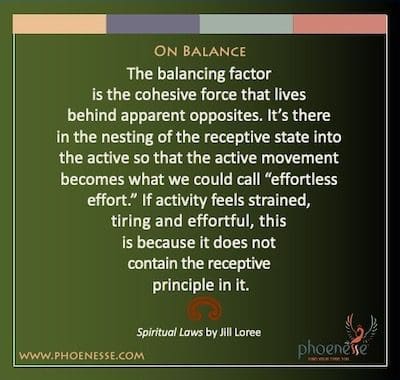Here on this dualistic sphere we have qualities like harmony, beauty and love, and we also have their opposing not-so-charming aspects. And of course there are lots of stops in-between. Somewhere on this spectrum is where we each stand, waffling about whether to follow the line of least resistance—which always matches our lowest nature—or to take the high road—which is the narrow and more difficult path of following our Higher Self.

How then is a person judged in the Spirit World when we, say, really and truly want to find the truth, but then cop out and go for the easy way? For one thing, bear in mind that not all souls coming here are at the same level of development, not by a long shot. So the same is not expected of everyone.
Nonetheless, spiritual laws operate just as effectively if we align with the good as when we opt to take the low road; there will be an appropriate corresponding effect for whatever cause we set into motion. But more importantly, the design of spiritual laws funnels us in the right direction by making the consequences of going sideways increasingly unpleasant. So it’s not a matter of someone punishing us. In fact, there’s no punishment at all from on high. That notion has it all wrong.
The deal is, we punish ourselves. When we get off track from the plan for our lives, the life plan itself kicks in to bring us back in line. For we’ll never find fulfillment if we’re lost in the weeds. The more ignorantly we insist on proceeding down dark dead-end paths, the more out of balance we become and the more disharmony we will feel as we try to re-center ourselves.
This force works the same in nature as in our bodies and souls. So when we go contrary to our plan, it’s like having an earthquake or an avalanche hit our souls. That’s what we typically call a crisis. It’s a rough way to go about things, but when the dust settles, balance is restored.
Much of life is about achieving balance. In fact, all laws of physics, chemistry, biology—pretty much every conceivable science there is—are governed by the great law of balance. Some of these laws are obvious to scientists, but others are more intricate and we haven’t yet perceived them.
The beauty of all divine law lies in the way they are constantly moving us toward a state of being in balance, often using disintegration is a stepping-stone toward integration. We could say, then, that the Law of Balance is always integrating.
On the physical level, being in balance creates order. Imbalance, then, leads to disorder. That said, the temporary disorder of the deconstruction process is often a necessary step in the construction of a more orderly environment. Mentally, balance equates to sanity, which leads us toward more balance and ever-more clear thinking.
Emotionally, to be in balance is to be in harmony in our feelings. Imbalance, then, means to feel disharmonious within, which always indicates the presence of negative emotions. Pain is often the negative feeling that motivates us to restore harmony by dealing with its unpleasantness. Too often, though, we attempt to avoid our pain and therefore miss out on what it is bringing to our attention, on what needs integrating. As a result, we miss the opportunity to regain our balance and cause ourselves to live in a perpetual state of disharmony.
The balancing factor then is the cohesive force that lives behind apparent opposites. It’s there in the nesting of the receptive state into the active so that the active movement becomes what we could call “effortless effort.” If activity feels strained, tiring and effortful, this is because it doesn’t contain the receptive principle in it.
In fact, this is often the reason that people shy away from movement, from making an effort; it’s because we can’t feel the quiet within the active space. We then become stagnant since our effort feels so strained. What we need is a balance of the active principle—which is movement and action—together with the quiet state of being from the receptive principle.
The active goes out and the receptive takes in. The active is a tensing of energies and the receptive state relaxes. Combine the two in proper balance and our efforts will be calm and relaxed, while our receptivity will be vibrant and alive. In either case, both movements can be present, it’s just a matter of proportion. That’s what keeps everything in balance.
We can find another example of balance in the temperatures found here on Earth. Both warmth and cold are indispensable for harmonious living, but when out of balance, a hot bath can burn us or a cold wind can freeze our skin. Either way, when too far out of balance, they can kill.
Everything appearing as opposites then are simply the two halves needed to create a whole. So it is not possible to live fully in reality—to be in unity—and leave out any half. Our work, when we are struggling, is to search for the side we are missing, so we can integrate apparent opposites and live in balance. Often, the piece we need to face is our pain.
Next Chapter
Return to Spiritual Laws Contents


